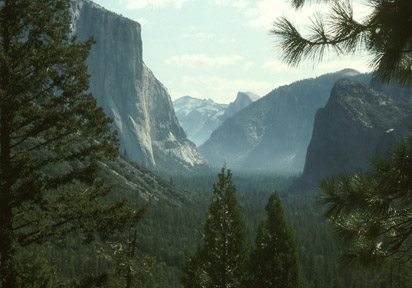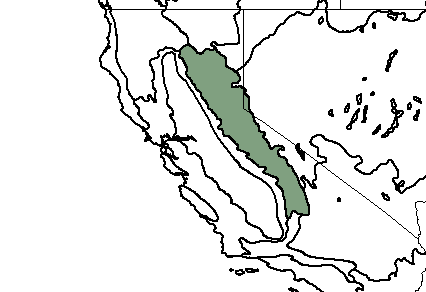
Yosemite Valley, Yosemite National Park, California (c) 2005 James H. Bassett
Bioimages home (click on an image to enlarge)
view
this page in its intended navigation context
Sierra Nevada Forests
(WWF
ecoregion
NA0527)

Yosemite Valley, Yosemite National Park,
California (c)
2005 James H.
Bassett

Source of bioregions data:
Olson, D. M. and
E. Dinerstein. The Global 200: Priority ecoregions for global conservation. (PDF
file) Annals of the Missouri Botanical Garden 89:125-126.
Distinctiveness (1=highest,4=lowest): 1
(globally outstanding)
This ecoregion contains one of the most diverse temperate conifer forests on
Earth. It has a wide range of habitat types and about 3500 species of
vascular plants, including 400 endemic species, and about 400 species of
vertebrates.*
Conservation Status (1=most endangered, 5=most
intact): 2 (endangered)
About 25% of the habitat is intact. Four national parks protect large
blocks of intact forest. Logging, grazing in wilderness areas, and air
pollution are threats.*
 | Pinus ponderosa | (ponderosa pine) |
 | Pseudotsuga menziesii | (Douglas fir) |
 Sequoiadendron gigantea
(giant sequoia) (c) 2004
Maurice J. Kaufmann
Sequoiadendron gigantea
(giant sequoia) (c) 2004
Maurice J. Kaufmann | Pinus monticola | (western white pine) |
 Populus
tremuloides (quaking aspen)
Populus
tremuloides (quaking aspen) | Tsuga mertensiana | (mountain hemlock) |
 Pinus albicaulis (white bark pine) (c) 2004
Maurice J. Kaufmann
Pinus albicaulis (white bark pine) (c) 2004
Maurice J. Kaufmann | Pinus contorta | (lodgepole pine) |
Associated habitats
Mixed valley forest, Yosemite National Park, California

(c)
2005 James H.
Bassett
hires
Giant sequoia grove, Yosemite National Park, California

Sequoiadendron gigantea
(giant sequoia)
(c)
2005 James H.
Bassett
hires
High elevation forest, Sequoya National Park, California

(c)
2005 James H.
Bassett
hires
Treeline, Yosemite National Park, California

(c)
2005 James H.
Bassett hires
* Ricketts, T.H., E. Dinerstein, D.M. Olson, C.J. Loucks, et al. (1999) Terrestrial Ecoregions of North America: A Conservation Assessment. World Wildlife Fund - United States and Canada. Island Press, Washington, D.C. pp. 244-248.
Except as noted, images copyright 2002-2004 Steve Baskauf - Terms of use